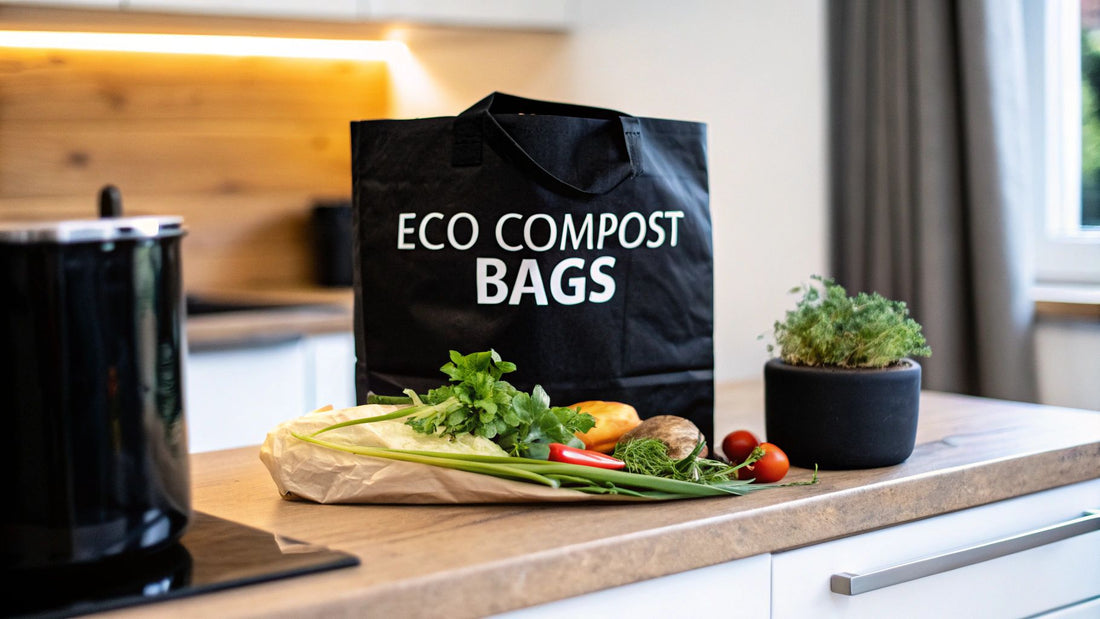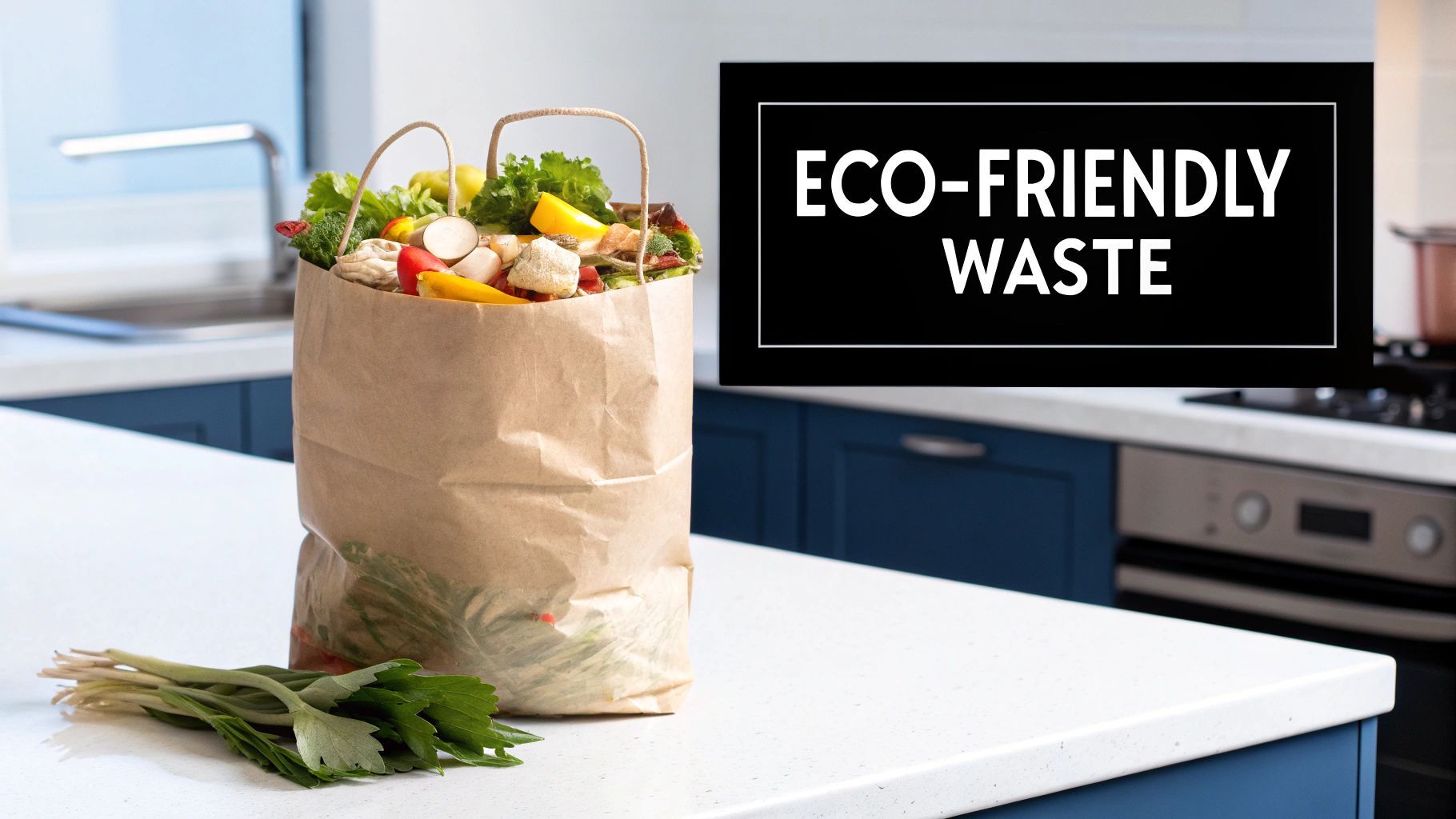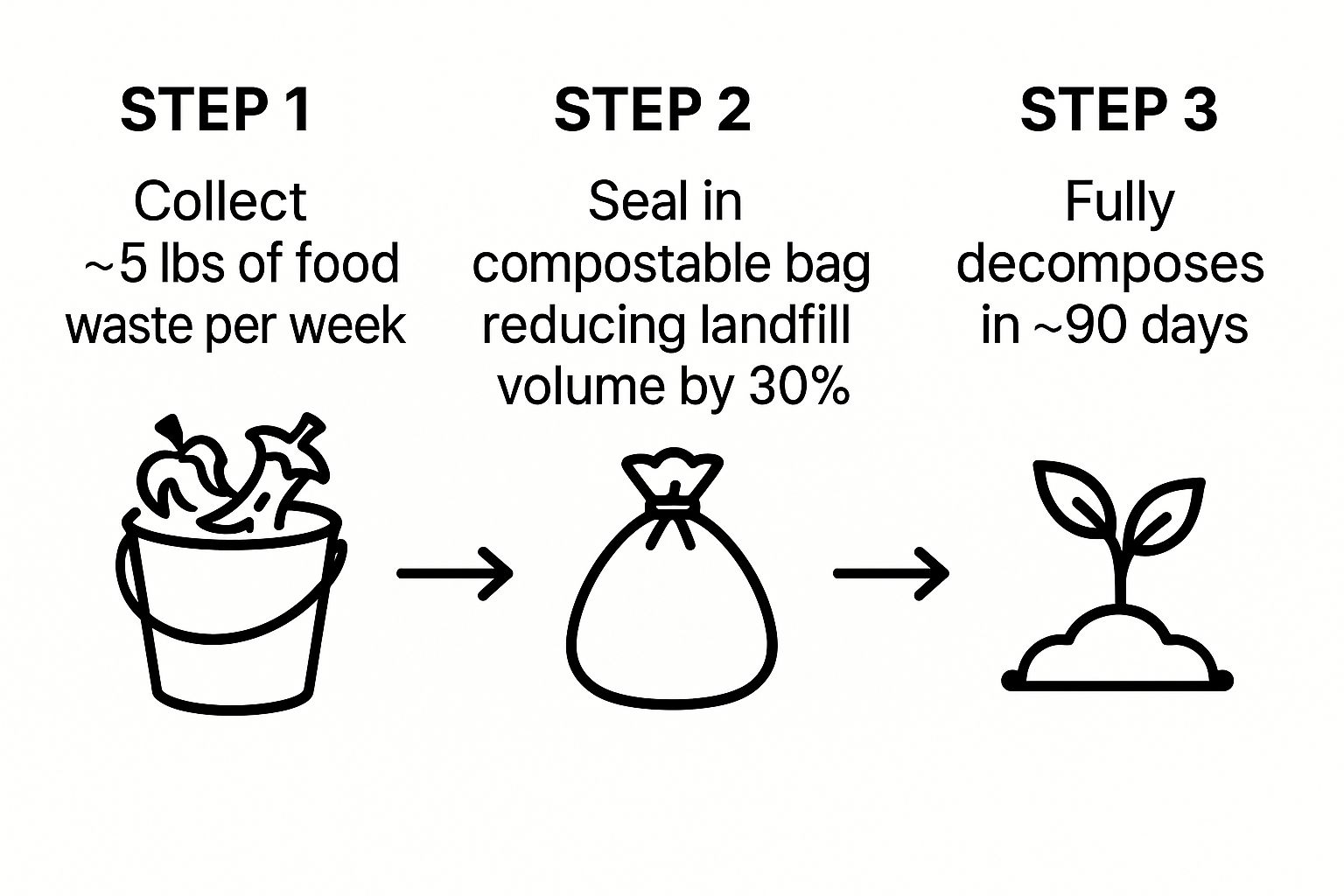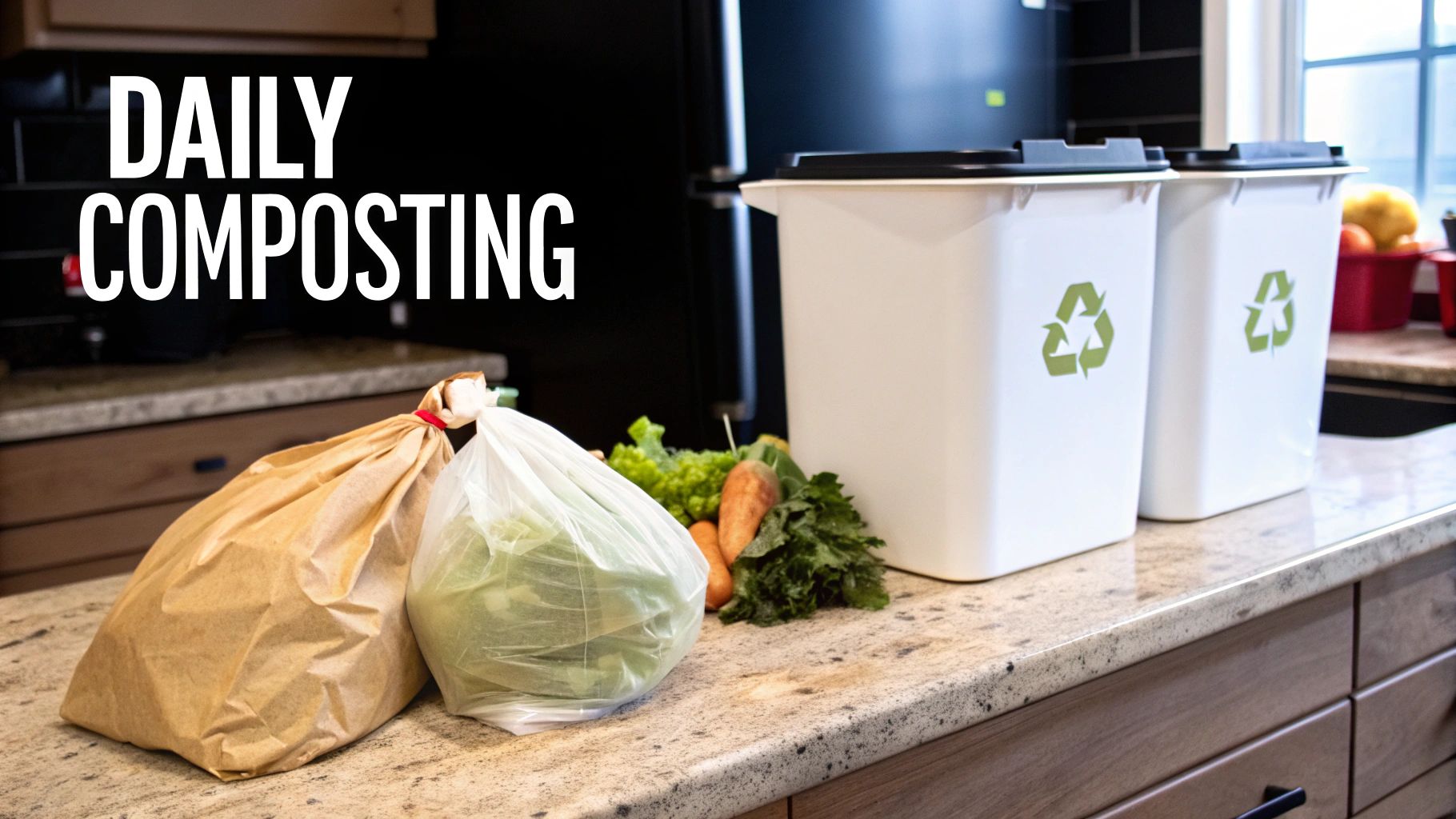
Your Kitchen Scraps Can Save the Planet. Yes, Really.
Share
Think about this for a moment: what if your daily food scraps—the coffee grounds, banana peels, and veggie trimmings—could help grow new food instead of just piling up in a landfill? It sounds almost too simple to be true, but switching to compostable bags for food waste makes it an everyday reality. This one small change in your kitchen routine transforms everyday waste into a powerful resource, helping to shrink our overflowing landfills and actively fight climate change.
Why Your Kitchen Needs Compostable Bags

Every single home produces food waste. It’s an unavoidable part of life. The real problem isn’t the waste itself, but where it tragically ends up. When we toss those scraps into the regular trash, they're hauled off to a landfill, and that’s where the environmental damage truly begins.
Buried deep under layers of other garbage, food waste is starved of oxygen. As it breaks down in this oxygen-free (anaerobic) prison, it releases methane—a greenhouse gas that’s over 25 times more potent than carbon dioxide at trapping heat in our atmosphere. This isn't a small issue; it's a massive contributor to climate change, happening in your local landfill right now.
The Landfill Problem vs. The Compost Solution
The sheer scale of this self-inflicted problem is staggering. In the United States, we throw away nearly 60 million tons of food every year. That’s about 40% of the entire country's food supply going uneaten. Even more shocking? In 2018, only a tiny fraction—a mere 4.1%—of that food waste was composted. You can dig deeper into the data on food waste in America to see the full picture of this massive missed opportunity.
This is exactly where compostable bags flip the script. Don't just think of them as a bin liner; see them as the first critical step in a powerful, natural recycling process.
By using a compostable bag, you're essentially gift-wrapping your food scraps for their true destination: a compost pile. There, with plenty of oxygen, moisture, and helpful microorganisms, they break down into nutrient-rich soil, completing a cycle that nature intended.
The Ripple Effect of a Small Change
Making the switch to compostable bags is about so much more than just taking out the trash differently. It’s a conscious, powerful choice that has a real, positive impact. In fact, it's one of the easiest and most direct ways any of us can take part in solving a global problem right from our own kitchens.
This one simple action helps to:
- Slash Methane Emissions: Every bag of food scraps you divert from the landfill is a direct reduction in harmful greenhouse gases.
- Create Healthier Soil: The compost produced enriches our soil, boosts water retention, and cuts down on the need for chemical fertilizers.
- Keep Waste Streams Clean: Using the right bags keeps food waste separate, making both the composting and recycling processes far more efficient for everyone.
It’s astonishing how a small tweak to your daily routine can create such a powerful ripple effect, turning your waste back into a resource that helps heal the planet.
What Does 'Compostable' Actually Mean?

When you're trying to do the right thing for the planet, you get bombarded with words like "eco-friendly," "green," and "biodegradable." It's easy to get lost in the marketing noise. Let's focus on the one term that truly matters for your food scraps: compostable. This isn't just a fancy word; it’s a specific, verifiable promise about how a product returns to the earth without causing harm.
Think of a compostable bag like an apple core. When you toss an apple core into a compost bin, it doesn’t just vanish. It breaks down completely, becoming a part of the rich, dark, nutrient-packed material that gardeners call "black gold." A truly compostable item does the exact same thing, completing a natural and beneficial cycle.
This is a world away from a regular plastic bag, which comes from petroleum and haunts our planet for hundreds of years, shedding toxic micro-shards. It's also not the same as products vaguely labeled "biodegradable," a term that often means very little without a specific timeframe or set of conditions. A so-called biodegradable bag might just break apart into microplastics, creating pollution instead of healthy soil.
The Plant-Based Power Behind Compostable Bags
So, what’s the secret sauce that gives compostable bags for food waste this superpower? It all comes down to what they're made of. Instead of oil, these advanced bags are created from renewable, plant-based materials like cornstarch or sugarcane.
A very common ingredient is Polylactic Acid (PLA), a bioplastic made from fermented plant starches. When you put a PLA bag into a hot, active compost pile, the tiny microorganisms see it as a meal. They get to work, consuming the bag and breaking it down into three simple, harmless things:
- Water
- Carbon Dioxide
- Biomass (the good stuff that enriches soil)
This complete decomposition is what makes certified compostable products so special. There's no toxic gunk or plastic confetti left behind—just valuable compost ready to help new plants grow. It's a perfect, closed-loop system in action.
The Critical Difference: 'Biodegradable' vs. 'Compostable'
It's tempting to think these two words mean the same thing, but they are worlds apart. Nailing this difference is the key to making a choice that truly helps the environment.
A common mistake is thinking all biodegradable products are compostable. The truth is, all compostable items are biodegradable, but not all biodegradable items are compostable. It’s a one-way street, and understanding it can make or break your green efforts.
Here’s a simple way to see the difference:
| Feature | Biodegradable | Compostable |
|---|---|---|
| What It Means | Can be broken down by microbes over some amount of time. | Breaks down into natural, non-toxic elements in a specific setting and timeframe. |
| End Product | Might leave behind microplastics or chemical residue. | Creates nutrient-rich organic matter, also known as humus or compost. |
| Timeframe | Not defined. Could be a few years or a few hundred. | Must break down within a set period (like 90-180 days) in compost conditions. |
| Regulation | Vague term, often used for "greenwashing" to make a product seem eco-friendly. | Held to strict certification standards (like BPI) that prove the claim. |
When you reach for a certified compostable bag, you're not just crossing your fingers and hoping it disappears. You're choosing a product that has been scientifically designed and tested to become a resource for the earth again.
The Science of How Compostable Bags Disappear
A truly compostable bag is designed to do something remarkable: disappear completely and return to the earth. This isn't magic, though—it's all about science. For a bag to properly break down, it needs the perfect combination of heat, moisture, and hungry microorganisms, which are the tiny powerhouses of the composting world.
Think of it like baking a cake. You can have all the right ingredients ready to go (the bag and your food scraps), but if you just stick them in a cold oven, you're not going to get a cake. In the same way, if you toss compostable bags for food waste into a landfill, they're starved of the oxygen and microbial life they need to decompose. Buried under tons of other trash, they get trapped in an airless tomb, unable to complete their natural cycle.
Industrial Facilities Versus Home Compost
The "oven" in our analogy is the composting environment itself, and they're not all created equal. The two main types you'll encounter are industrial composting facilities and your standard backyard compost pile, and each one works very differently.
-
Industrial Composting: These large-scale operations are the professional bakeries of the compost world. They use specialized equipment to manage conditions with precision, reaching sustained high temperatures—often between 131-170°F (or 55-76°C). This intense heat is strong enough to break down even tough materials like bioplastics and bones. Most certified compostable bags are specifically designed to work in these powerful systems.
-
Home Composting: A backyard compost bin is more like a slow cooker. It operates at much lower, more variable temperatures and relies on a different community of microorganisms. While it's fantastic for breaking down yard trimmings and many types of food scraps, it often doesn't get hot enough to fully decompose all certified compostable products, at least not in a reasonable amount of time.
Proper disposal is the key that unlocks a compostable bag's environmental benefits. Sending it to the right facility ensures it completes its journey from a useful product back to valuable, nutrient-rich soil.
The image below shows how a simple action at home—using the right bag for your food scraps—can create a huge environmental win when everything is composted correctly.

This whole process shows how collecting food scraps in compostable bags doesn't just divert waste from landfills. It also ensures those materials break down completely, often within about 90 days, when they end up in the right conditions.
Why Proper Disposal Is Everything
Choosing the right way to get rid of your compostable bag is absolutely critical. A compostable bag tossed in the trash and sent to a landfill is not just a wasted opportunity—it’s a tragedy. But when that same bag is sent to the right composting facility, it becomes part of a bigger, greener solution.
To understand why the environment matters so much, let's compare how these bags fare in different settings.
Decomposition Environments Compared
This table shows how compostable bags break down in different environments, highlighting why proper composting is essential.
| Environment | Conditions | Outcome for Compostable Bag | Timeframe |
|---|---|---|---|
| Industrial Compost | High heat (131-170°F), oxygen, moisture, microbes | Fully biodegrades into soil, water, and CO2 | ~90 days |
| Home Compost | Lower heat, variable oxygen and moisture | May break down slowly or not at all | 6 months to 2+ years |
| Landfill | No oxygen, low moisture, limited microbial activity | Preserved indefinitely, may release methane | 100+ years |
| Open Environment | Sun, rain, oxygen | Breaks into smaller plastic fragments (microplastics) | Years to decades |
As you can see, only an industrial composting facility provides the ideal recipe for these bags to fulfill their purpose.
This is exactly why many cities and towns have specific rules about which bags are allowed in their green bin programs. They have to make sure that whatever they collect will actually break down in their systems. This careful management is what turns our food scraps from a potential climate problem into a resource that brings life back to our soil.
How to Choose the Best Compostable Bag (and Avoid a Mess)
Feeling a bit lost staring at the wall of compostable bags? It's easy to get overwhelmed by all the different boxes and claims. But don't worry—once you know what to look for, picking the right bag is actually pretty simple. Let's walk through how to choose a bag that will genuinely help your composting efforts, not sabotage them.
The absolute first thing you must scan for is a third-party certification logo. This is your non-negotiable. Think of it as a seal of approval from an unbiased expert, confirming the bag will actually break down as promised. Without it, you're just gambling, and you might end up with a "greenwashed" bag that contaminates an entire batch of compost.
What to Look For on the Label
When you're at the store, flip the box over and search for these specific logos. They’re the gold standard and your proof that you’re buying the real deal.
-
BPI Certified: In North America, the Biodegradable Products Institute (BPI) is the leading authority. Seeing the BPI logo means the bag has passed rigorous scientific tests and is certified to break down completely in a commercial composting facility.
-
TÜV AUSTRIA (OK compost HOME / OK compost INDUSTRIAL): This is a globally respected European certification. The key here is to look for which type it is. "OK compost HOME" is for bags you can toss in your backyard compost pile. "OK compost INDUSTRIAL" is for bags that need the high heat of a municipal facility, making them perfect for your city's green bin program.
Picking a certified bag is like hiring a licensed contractor instead of a random person from the internet. You get peace of mind knowing it will do the job right and won't cause problems down the line for the composting facility.
Size and Thickness: The Practical Details
Once you've confirmed a bag is certified, the next two things to think about are size and thickness. These details make all the difference between a clean process and a frustrating mess.
First up, get the size right. A bag that's too small is a recipe for disaster—it'll constantly slip down into the bin and create a nasty cleanup job. One that's too big is just a waste of material and money. The best approach is to measure your compost pail and grab a bag that gives you a few inches of overhang to fold neatly over the rim.
Next, check the thickness, which is measured in mils. For wet, heavy food scraps, you must choose a thicker bag, somewhere in the 0.8 to 1.0 mil range. It will give you the strength you need to avoid rips and leaks. For instance, you can find options like these extra-thick 1.0 mil compostable bags for food waste that are built to handle the job without splitting open. Cheaper, thinner bags might seem like a good deal, but they often end in frustrating spills. A sturdy bag just makes the whole process cleaner and far more pleasant.
5 Tips for Making the Most of Your Compostable Bags

So you've made the switch to compostable bags for your food waste—that's a fantastic decision! But you might notice they behave a little differently than the plastic bags you're used to. Since they're designed to break down, a few simple tricks can keep your composting experience clean, easy, and completely mess-free.
Think of it this way: your compostable bag has already started its journey back to the earth the moment you put something wet inside. With that in mind, you can easily avoid common issues like leaks, smells, or tears.
Keep Things Clean and Dry
Moisture is the biggest enemy of a compostable bag sitting in your kitchen. An easy fix is to line the bottom of the bag with a folded paper towel or a scrap of cardboard before you add any food. This little barrier does wonders to soak up liquids from things like watermelon rinds or coffee grounds, keeping the bag strong and intact.
Because the bag starts to weaken with moisture, you must take out your food scraps every 2-3 days. Waiting any longer is just asking for a leaky surprise when you go to lift the bag out of the bin.
Smart Ways to Avoid Common Problems
A little bit of planning can make composting a breeze. These tips will help you manage your food scraps without any stress.
- Cool It Down: Never toss steaming hot leftovers directly into the bag. The heat and moisture will speed up the decomposition process. Let them cool to room temperature first.
- Drain the Drips: Before you throw in wet items like fruit pulp or the brine from canned veggies, give them a quick drain in the sink. Less liquid means a stronger bag.
- Freeze the Funk: Got some extra smelly scraps like fish skins or onion peels? Pop them in a small container in your freezer and add them to the main bag right before you take it out.
A helpful way to think about it is that your compostable bag is a temporary ride for your food scraps, not a permanent home. Its main job is to get waste from your kitchen to the compost pile cleanly.
What to Do When the Bag Is Full
Once your bag is ready to go, sending it to the right place is key. If your town has a curbside green bin service, like the composting program in Portland, you can just tie up the BPI-certified bag and toss it in. These municipal programs are set up to handle them perfectly.
If you have a home compost pile, make sure your bags have the "OK compost HOME" certification. Bags without it are designed for industrial facilities and won't break down properly in your backyard setup. If you don't have either of those options, see if a local community garden or commercial composter accepts drop-offs. Disposing of your bag correctly is what makes the whole effort worthwhile.
The Global Shift Towards Composting
When you decide to use compostable bags for food waste, you’re doing more than just keeping your kitchen clean. You're plugging into a powerful, worldwide movement that's completely changing how we think about our trash. It’s a small step at home that connects you to a much larger, collective push for a healthier planet.
This isn’t just some niche trend. We're seeing cities, states, and entire countries put rules in place that encourage—or even require—people to separate their organic waste. From San Francisco to Vermont here in the U.S., and across the European Union, new policies are popping up to keep food scraps out of landfills and transform them into something genuinely useful.
Why the Momentum Is Building
So, why is everyone suddenly talking about composting? The reason is simple: it just works. It helps us tackle massive environmental problems like overflowing landfills and the release of methane, a potent greenhouse gas. At the same time, it creates incredibly nutrient-rich soil that our farms and gardens desperately need.
The more people realize this, the more support systems are built, making it easier than ever for regular households to get involved.
The numbers tell the same story. The global market for compostable bags was valued at around USD 374 million in 2023. By 2030, it’s expected to climb to an impressive USD 610 million. That's a growth rate of 7.4% every year, fueled by new regulations and people like you demanding better, greener options.
Seeing this worldwide trend provides powerful social proof. It confirms that your personal choices are not made in isolation but are amplified by millions of others, creating a ripple effect that leads to real, systemic change.
This momentum solidifies composting's place as a cornerstone of modern, responsible waste management.
Your Role in This Bigger Picture
Every time you fill a compostable bag with food scraps, you're essentially casting a vote for a healthier planet. This growing network of composting programs is built on the simple actions of individuals who recognize that their leftovers are far too valuable to just throw away.
Here’s a quick look at how your efforts connect to the global movement:
- You create demand: Buying certified compostable products sends a clear message to companies: we want more sustainable goods.
- You support local systems: When you use your city's green bin program, you help it run smoothly and make a strong case for expanding these services to more people.
- You inspire others: Your friends and family are much more likely to start composting themselves once they see how easy you make it look.
Your commitment is a vital piece of this success story. As you continue on your composting journey, you can check out our blog for more tips and stories about living a more sustainable life.
Your Questions About Compostable Bags Answered
Switching to compostable bags is a great move, but it's natural to have a few questions. Let's walk through some of the most common ones so you can feel confident you're doing it right from day one.
Are Compostable Bags More Expensive?
Yes, you might notice that compostable bags cost a bit more upfront than their traditional plastic counterparts. But it helps to think of them less as a simple liner and more as a vital tool for a healthier planet.
Their real value shines when you consider what they achieve: diverting food waste from landfills. This single act slashes harmful methane gas emissions and helps turn your scraps into valuable, nutrient-rich soil. That small extra cost is really an investment in a much larger, more sustainable cycle.
How Should I Store Them?
This is a great question. Because these bags are designed to break down, they do have a shelf life. To keep them strong and ready for action, you'll want to store them in a cool, dark, and dry spot.
Keep them away from direct sunlight and any moisture. A pantry cupboard or the cabinet under the sink is usually perfect. Stored this way, an unopened box will easily last for up to a year.
Can I Use Them in My Home Compost Pile?
Pay close attention to this one—it’s crucial. You should only toss these bags into your backyard compost if they are specifically certified for it. Look for the "TÜV AUSTRIA OK compost HOME" logo on the packaging.
Most other bags, even those with BPI certification, are designed for the intense heat of an industrial composting facility. They simply won't break down properly in the cooler environment of a home pile.
Choosing the right bag for the right system is the single most important factor for success. Using an industrial-only bag in a home pile is like trying to bake a cake with the oven turned off—the necessary conditions simply aren't there.
If you’re ever unsure about which bags work with your local composting program or your home setup, it's always best to ask. You can contact us for guidance, and we'll help you make the perfect choice.
Ready to make a simple switch with a big impact? Myterravera offers high-quality, certified compostable bags that make reducing waste effortless. Start your composting journey today at https://www.myterravera.com.
